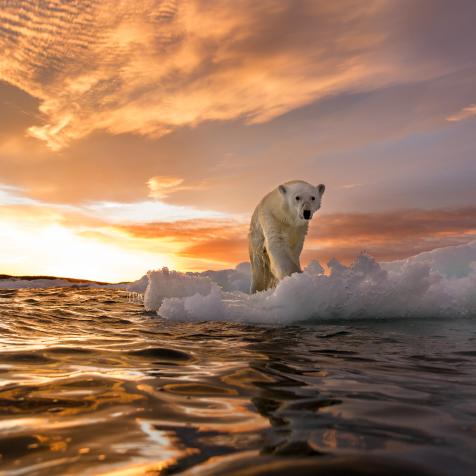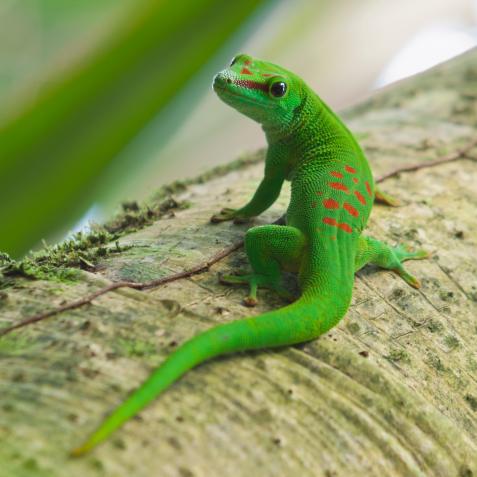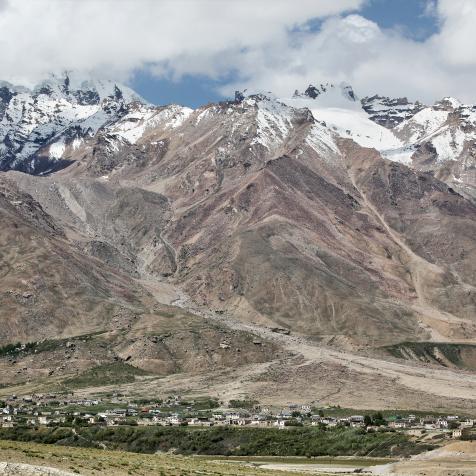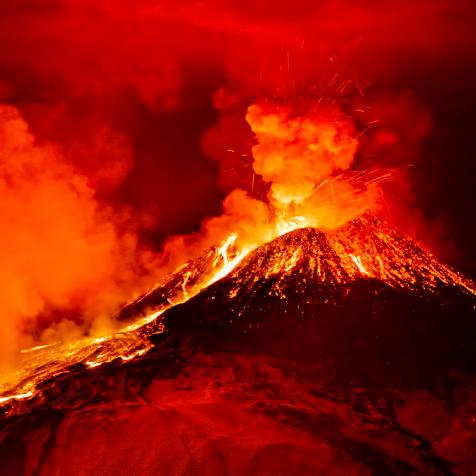
Handout
Tracking Hurricane Dorian: Here's Everything You Need to Know
Here is what you need to know about the tropical cyclone making its way to the U.S. mainland.
As of August 30, Hurricane Dorian was reclassified as a Category 2 storm and is expected to intensify into a Category 3 hurricane this afternoon, with sustained wind speeds anticipated to reach more than 111 mph. As of 11 a.m. ET, Dorian’s center was located 660 miles east of West Palm Beach, Florida and 480 miles east of the northern Bahamas.
Dorian is expected to make landfall late Monday or early Tuesday, likely over Florida’s Atlantic coast or possibly further south. There is a possibility that the storm will intensify into a Category 4 hurricane with wind speeds reaching more than 140 mph.
8 Most Disastrous Hurricanes on Record 8 Photos
As we enter hurricane season, here are eight of the most disastrous hurricanes to strike the Atlantic basin in no particular order.
In response to this tropical cyclone, Florida Governor Ron DeSantis has declared a state of emergency and activated 2,500 Florida National Guard troops. The University of Miami has closed school from Friday through Tuesday.
Sunday, Sep. 1, 2019: Dorian has been upgraded to a Category 5 hurricane with sustained wind speeds measuring more than 160 mph. As it moves towards the US coast, it is expected to slow to a crawl over the Northern Bahama islands causing life-threatening storm-surge, heavy rainfall, and intense winds.
4 am chase update. pic.twitter.com/kSHHu9E7w1
— Josh Morgerman (@iCyclone) September 1, 2019
Current models predict that Hurricane Dorian will make landfall in Florida and move north, affecting Georgia and the Carolinas.
Hardcore storm-chaser, Josh "The Hurricane Man" Morgerman is currently pursuing the storm. Stay tuned for updates.
6:10 am. Rainband sweeping in. #DORIAN #Bahamas pic.twitter.com/h8BcaLQipG
— Josh Morgerman (@iCyclone) September 1, 2019
Monday, Sep. 2, 2019: Dorian, now a Category 4 hurricane, continues to bear-down on Grand Bahama Island as it has slowed to a crawl of about 1 mph. The storm is located approximately 30 miles northeast of the Bahamian city of Freeport and 110 miles east of West Palm Beach, Florida.
Dorian is the strongest hurricane to ever hit the Bahamas, with a sustained wind speed of 185 mph, gusts up to 200 mph, and storm surges up to 23 feet above normal tides. Casualties have been reported and citizens are being urged to remain indoors due to extensive damage.
As Dorian creeps towards the US coast, hurricane warnings have been extended throughout the southeastern US. Major ports across Florida’s eastern coast have been closed, including Miami, and many nursing homes, assisted living facilities and hospitals are preparing to evacuate.
Storm-chaser Josh “The Hurricane Man” Morgerman last reported from the Bahamas' Abaco Island, just outside of the eyewall of the storm:
8:17 am. Gusts getting scary in Marsh Harbour. I feel like a rocket is about to take off. Bandwidth down to almost nothing, so this is possibly the last you'll hear from me for a long while. This is gonna get ugly. #DORIAN #Bahamas
— Josh Morgerman (@iCyclone) September 1, 2019
11:15 am. 978 mb & falling fast. Just outside eyewall, but winds will damaging. Holed up with six others in concrete room with chairs against the door. #DORIAN
— Josh Morgerman (@iCyclone) September 1, 2019
11:40 am. Pounding. CRASHING. Boards prying off windows. We're moving children to a safe space, wrapping them in blankets. 969 mg. #DORIAN
— Josh Morgerman (@iCyclone) September 1, 2019
Tuesday, Sep 3, 2019: Dorian is weakening. After dumping 30 inches of rain on Grand Bahama Island, the storm has been downgraded to a Category 2 hurricane with a sustained wind speed of 110 mph. Current forecasts indicate that the storm will skirt Florida’s eastern coast as it moves north towards Georgia, before finally making landfall in the Carolinas.
Though the storm has weakened in intensity, it has grown in size. The National Hurricane Center is urging those in the storm’s path to take all necessary precautions. CNN reports that “hurricane-force winds extend out 60 miles from the center of the storm, while tropical-storm force winds extend out 175 miles.”
Dorian is one of the slowest moving hurricanes on record, moving only 30 miles in 30 hours. It has already claimed the lives of 5 on Abaco Island in the Bahamas—and the death toll is expected to rise.
UPDATE: NOAA’s #GOES16 satellite is keeping a close eye on #HurricaneDorian, as the #hurricane starts to slowly push away from a battered #GrandBahamaIsland. Get the latest from @NHC_Atlantic #flwx #gawx #scwx #ncwx pic.twitter.com/Mfbb37UUIM
— NOAA Satellites PA (@NOAASatellitePA) September 3, 2019
#HurricaneDorian as seen from @Space_Station earlier today. Hoping everyone in its path stays safe. pic.twitter.com/6vejLDPJHF
— Christina H Koch (@Astro_Christina) September 2, 2019
Josh "The Hurricane Man" Morgerman described the storm as "the most intense cyclone I’ve witnessed in 28 years of chasing... whole neighborhoods were swept away by mighty surge higher than anything in memory," and provides the hair-raising details of his experience:
Yep, I’m alive. Made it to Nassau. #Hurricane #DORIAN: By far the most intense cyclone I’ve witnessed in 28 years of chasing. Thought I was playing it safe by riding it out in a solid-concrete school on a hill in Marsh Harbour. Thought wrong.
— Josh Morgerman (@iCyclone) September 3, 2019
Whole neighborhoods were swept by mighty surge higher than anything in memory. Areas above water had catastrophic wind damage. Many deaths reported from drowning, flying debris, & collapsing houses. Medical clinic overwhelmed. An absolute catastrophe. SEND HELP TO ABACO ISLANDS.
— Josh Morgerman (@iCyclone) September 3, 2019
Frantically piled into few functioning cars (one of them mine) & relocated to government complex before backside struck. Building filled with terrorized refugees, many who had swam to safety or abandoned collapsed houses. The calm eye saved lives—gave victims chance to relocate.
— Josh Morgerman (@iCyclone) September 3, 2019
Though rescue efforts are underway, first responders are overwhelmed by the destruction with severe flooding and debris miring their efforts.
Thursday, Sep 5, 2019: Hurricane Dorian, now a Category 2 storm, looms just 70 miles off of the US coastline. The storm's outer-bands are already wreaking havoc on coastal communities throughout the Carolinas with reports of tornadoes, extensive flooding, and extreme wind conditions continuing to surface. Current forecast anticipate that the slow-moving storm will make landfall this afternoon. After witnessing the devastation this storm caused in the Bahamas, local officials are taking all the necessary precautions. Both North Carolina and South Carolina have declared a state of emergency, activating National Gaurd Soldiers and first responders.
Despite being downgraded to a Category 2 storm, Dorian is still quite dangerous. As the eyewall, the strongest part of the storm gets closer to the Carolinas, conditions are expected to worsen. Dorian is currently about 50 miles southeast of Charleston, South Carolina and 140 miles south of Wilmington, North Carolina.
Friday, Sep 6, 2019: Category 1 hurricane, Dorian finally made US landfall in Cape Hatteras, North Carolinas with sustained wind speeds exceeding 90 mph. Power outages have been reported in coastal communities and widespread flooding is amongst the most severe on record.
Meanwhile, Bahamian residents and first responders are still reeling in the wake of the storm. Josh "The Hurricane Man" Morgerman, who weathered the storm to collect scientific data, described it as "the worst cyclone disaster I've witnessed." He continues to document the "jaw-dropping" devastation on Abaco Island, where whole neighborhoods have been washed away by the storm.
The National Hurricane Center and the Central Pacific Hurricane Center are currently tracking multiple disturbances—a tropical cyclone forming near the northwestern Bahamas and Tropical Storm Kiko, a storm that is expected to strengthen into a hurricane in the Eastern North Pacific.
Discovery holds the Bahamas close to our hearts as it is home to some of the world’s most groundbreaking shark research. Text DORIAN to 707070 to contribute to disaster relief funds providing care and recovery to the Bahamian community.



















